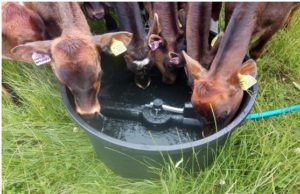As we know, grass is an economic feed source, and can be a good nutritional feed source for rearing youngstock. It must be carefully planned and budgeted for to be beneficial; economically and to reach targets.
Typically, feeding dairy heifers represents a small proportion of the overall farm feed budget, though a good plane of nutrition is required to ensure heifers are 60% of their mature weight ready for breeding. For a 750kg mature Holstein, they must be 450kg by the time they are put for 1st insemination.
At around 300-350kg, heifers should be eating at least 2% of their liveweight of good quality feed (6.5-7kg DM+) daily. In fresh weight, at 18% DM, this equates to 35-40kg + of grass per day. Like their dairy cow counterpart, monitoring grass swards and quality is essential to ensure there is enough feed, and when to supplement to achieve targets.
Top tips for grazing youngstock
- Ensure grass covers are not too heavy (2,700 kg DM/ha can be “overwhelming” for heifers). Aim to graze at the two-leaf stage where covers are around 2,400 to 2,500 kg DM/ha. Exit levels should be around 1,500 kg DM/ha which can be followed by an older group of heifers to hit the residual target. But ensure not to damage regrowth.
- If possible, move heifers every 2-3 days to prevent back grazing and ensure that they are presented with fresh feed.
- Continue to feed some concentrate once turned out to ensure smoother transition whilst avoiding a growth check.
- A fresh, plentiful supply of water should be provided with sufficient flow. Troughs should be able to provide 10 litres per heifer per hour. Ensure the trough size is appropriate for heifers, small portable plastic troughs or smaller fixed
troughs. - Change of weather must be accounted for. If it turns wet and/or cold, provide some form of shelter or housing to mitigate any fall in growth rates, in addition to extra feeding in the form of concentrates of conserved forage.
- Weigh and monitor growth rates regularly to ensure targets are maintained and to identify any individuals which may need extra attention.
- Devise a health and parasite management plan with your vet, to mitigate any impacts which parasites could have on achieving
 growth rates.
growth rates.
Key points
- It is important to ensure that autumn born heifers are robust enough to be turned out. Ensuring calves have enough good quality colostrum is essential followed by rumen development; begin weaning at a minimum of 6 weeks of age before implementing a step-down weaning process, ideally over 2 weeks to avoid any growth checks, so that calves are fully weaned by 8-12 weeks old.
- It takes 3 weeks of eating grass/concentrate for the rumen to adapt and grow enough bacteria to produce useful energy for growth. This highlights the importance of feeding concentrates alongside the milk feeding phase.

